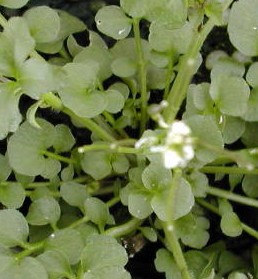 Also called flickweed, this annual weed is native to Europe and Asia but is widespread in the US and Canada. It grows in sun or shade and in damp or dry soil, but prefers damp, recently disturbed soil and is common in green houses and nurseries. Hairy bittercress is often introduced into gardens via new plants and will quickly spread through out the garden and into the lawn.
Also called flickweed, this annual weed is native to Europe and Asia but is widespread in the US and Canada. It grows in sun or shade and in damp or dry soil, but prefers damp, recently disturbed soil and is common in green houses and nurseries. Hairy bittercress is often introduced into gardens via new plants and will quickly spread through out the garden and into the lawn.
Description
A member of the mustard family (Brassicaceae), hairy bittercress grows in a clump six to twelve inches high and has wiry green stems and small rounded lobed leaves. The small four petaled white flowers are produced in racemes in spring and give way to dry slender fruits that burst when touched, distributing the seeds over a wide area up to 6 feet from the source. Seeds germinate in the autumn and tiny green plants overwinter. Plants grown in moist soil form a taproot while those in dry soil do not.
Control
Hairy bittercress is easy to pull out or can be cut with a hoe. Since the weed is an annual, it is important to remove the plant before it goes to seed. Preventative measures include examining nursery bought plants and removing weeds before planting.